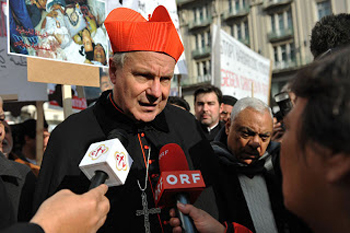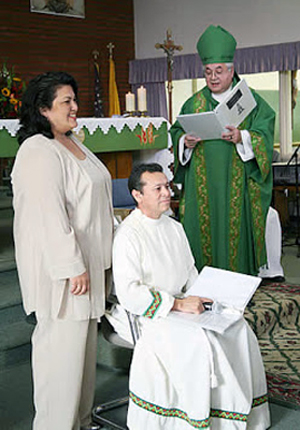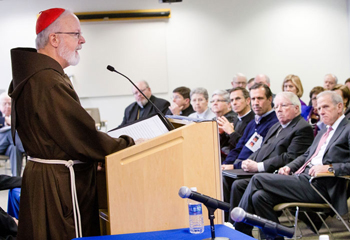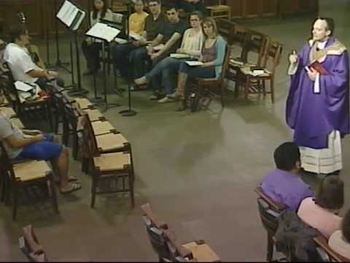A Column of Catholic Orientation
 |
 |
 |
 |
 |
 |
 |
Starting the Church of the Future
in Vienna & Boston
My friend Jan asked me if I had any ideas about what 2013 would bring for the Church. I am not one to make prophecies. In this case, however, I only had to look back to a column by Atila Guimaraes from last year to have a good idea of where the Church is heading. In it, he pointed out a grossly overlooked press conference of Cardinal Cristoph von Schönborn, the intellectual disciple of Benedict XVI.
The Archbishop of Vienna predicted that Catholics would finally have to say good-bye to the Church of the past; the future would bring radical internal changes to her. Offering the excuse of the drastic priest shortage and dwindling number of Catholics in the pews, Schönborn predicted parishes will be restructured and the laity trained to assume more ministries.
True to his word, Card. Schönborn spent last year implementing a plan for change in his Archdiocese, what he called “the greatest structural reorganization of the Vienna Archdiocese for 200 years” (The Tablet online, Sept. 27, 2012). In another press conference, again largely unnoticed in the media, he announced the reduction of the 660 parishes in the Archdiocese of Vienna to just 150 in the next 10 years, an astonishing cut of 75%.
Doing this, I point out, he follows in the steps of Bavarian Bishop of Augsburg who recently announced a similar plan to close 800 of the 1,000 parishes in his diocese.
‘Doing it the right way’ in Vienna
In another interview with National Catholic Reporter, Card. Schonborn explained the future face of the Church that will emerge in Vienna. In the beginning, the reception to the closing of churches was mixed, he admitted, but now most are becoming reconciled to the changes demanded by the Vatican II Church.
 “Many priests and lay people are glad that something is moving because they know stagnation would not be a solution. It would only increase depression and discouragement. We all know that changes have to be made,” the Cardinal explained. He added. “We have to do something, and we’re trying to do it the right way.” (Interview with Card. Christoph Schönborn,” NCR, Oct. 25, 2012)
“Many priests and lay people are glad that something is moving because they know stagnation would not be a solution. It would only increase depression and discouragement. We all know that changes have to be made,” the Cardinal explained. He added. “We have to do something, and we’re trying to do it the right way.” (Interview with Card. Christoph Schönborn,” NCR, Oct. 25, 2012)
What is the “right way” to get rid of Catholic churches? Instead of selling churches or simply closing them, Card. Schönborn proposes giving them to other so-called Christian churches that are growing instead of shrinking. He names, for example, “the [Schismatic] Copts, the Serbian Orthodox and the Romanian Orthodox,” whose numbers are allegedly on the increase. He also suggests that in some cases lay groups – even inter-denominational ones – may take over the churches and make “vibrant centers of spiritual life on another level.”
So, instead of making every effort possible to convert the Schismatics and Protestants to the true faith, the Cardinal of Vienna will hand over the empty churches to them. It is a blatant and shocking denial of the missionary role of the Catholic Church.
De-clericalization of the Church
The restructuring plan calls not just for closing parishes, but also for greater lay involvement. Here, Schönborn explains, we come to the key idea, which was “extremely present” in the October Bishops’ Synod in Rome. That key idea is the role to be played by “the small Christian community,” which represents an important element of the New Evangelization.
 “We’re forced to reduce the number of parish structures with all their administration and expenses,” Card. Schönborn says, “but we want to favor a growing number of small Christian communities led by laity – laity who aren’t full-time, who aren’t bureaucrats, but volunteers.” By utilizing the lay “people living in the field,” he continues, Bishops “can implement more explicitly the great theme of Vatican II: the common priesthood of all the baptized, with the ministerial priesthood at its service.”
“We’re forced to reduce the number of parish structures with all their administration and expenses,” Card. Schönborn says, “but we want to favor a growing number of small Christian communities led by laity – laity who aren’t full-time, who aren’t bureaucrats, but volunteers.” By utilizing the lay “people living in the field,” he continues, Bishops “can implement more explicitly the great theme of Vatican II: the common priesthood of all the baptized, with the ministerial priesthood at its service.”
The restructuring will 'cluster' churches. For example, five small country parishes will form one greater parish. Their facilities will not necessarily close, but may be manned by small Christian communities led by trained laity, ecclesial movements or prayer groups.
By assuming more offices in the Church, he explains, the laity is assuming responsibility for evangelization. It is the new evangelization, what he calls mission. “The headline for the Archdiocese of Vienna is ‘Mission First.’ We even said it in English!”
The Boston plan
Evangelization and Mission were the same terms used by Boston Cardinal Sean O’Malley at a Chicago news conference in November 2012. He also announced a pastoral plan to restructure his Archdiocese’s 286 parishes.
In 2004, O’Malley ran into keen resistance from many parishioners when he closed 83 churches. Today he has wised up. There is no talk of closing churches, just restructuring the parishes into 135 “collaboratives,” which, despite the window-dressing, amounts to a 56% reduction of parishes. ("New Pastoral Plan in Boston," NCR, Dec. 12, 2012)
 The Boston “collaborative” is the same as the Vienna “cluster”: a grouping of parishes led by one pastor and a pastoral team and council. The plan, called “Disciples in Mission” is essentially “parish-based evangelization work,” explained Fr. Paul Soper, the recently named Director of Pastoral Planning. "I think that we're at a critical moment in the life of the Church in the United States, and in Boston in particular," Soper said. "It's really something of a turning point."
The Boston “collaborative” is the same as the Vienna “cluster”: a grouping of parishes led by one pastor and a pastoral team and council. The plan, called “Disciples in Mission” is essentially “parish-based evangelization work,” explained Fr. Paul Soper, the recently named Director of Pastoral Planning. "I think that we're at a critical moment in the life of the Church in the United States, and in Boston in particular," Soper said. "It's really something of a turning point."
What amazes me is that the Hierarchy seems oblivious to the root cause for this critical point we have reached in the Church. The numbers are blithely given: In the 1970s 70% of Boston Catholics attended Mass; today that number is roughly 16%. In the 1970s the seminaries were still full; today the numbers are sparse. Parish priests numbered 822 in 2006, down from 1,430 in 1966. No one faces the fact that, behind the numbers, at the base of this crisis in the Church and the Faith is the new theology, moral doctrine, and spirit that have overtaken the Church in the wake of Vatican II.
Instead of addressing this problem, however, an optimistic note is taken with talk of mission and evangelization. The crisis, in short, presents the opportunity to achieve the goals of Progressivism: a de-clericalized Church composed of small, self-managed communities.
Ratzinger’s prediction fulfilled
The Church in the Vienna and Boston Archdioceses has plans in place now that will completely change her structure and face. And all this with the complacent nod of the present Pope, who predicted and praised this change in his 1971 book Faith and Future.
 Although we have printed those lines in various places on this site, I think it is worth repeating them here, especially for those Catholics who still maintain the delusion that this Pope is conservative. Sometime after the Council, Card. Joseph Ratzinger wrote these lines looking ahead to the “critical point” we have reached in the Church today:
Although we have printed those lines in various places on this site, I think it is worth repeating them here, especially for those Catholics who still maintain the delusion that this Pope is conservative. Sometime after the Council, Card. Joseph Ratzinger wrote these lines looking ahead to the “critical point” we have reached in the Church today:
“From today’s crisis, a Church will emerge tomorrow that will have lost a great deal. She will be small and will have to start from the beginning. She will no longer be able to fill many of the buildings created in her period of great splendor. … Contrary to what has happened until now, she will present herself much more as a community of volunteers. ...
"As a small community, she will demand much more from the initiative of each of her members, and also certainly she will acknowledge new forms of ministry and will raise up proven Christians who have a calling to the priesthood. The normal care of souls will be made by smaller communities, in social groups with some affinity. ….
"This will be achieved with effort. The process of crystallization and clarification will demand a great exertion. It will make her a poor Church and a Church of the little people.” (Petrópolis: Vozes, 1971, pp. 76-7.)
I believe that unfortunately we will be seeing more of these “restructuring plans” that have emerged in Vienna and Boston in the future, unless Our Lady intervenes in a timely and unexpected way.

The Archbishop of Vienna predicted that Catholics would finally have to say good-bye to the Church of the past; the future would bring radical internal changes to her. Offering the excuse of the drastic priest shortage and dwindling number of Catholics in the pews, Schönborn predicted parishes will be restructured and the laity trained to assume more ministries.
True to his word, Card. Schönborn spent last year implementing a plan for change in his Archdiocese, what he called “the greatest structural reorganization of the Vienna Archdiocese for 200 years” (The Tablet online, Sept. 27, 2012). In another press conference, again largely unnoticed in the media, he announced the reduction of the 660 parishes in the Archdiocese of Vienna to just 150 in the next 10 years, an astonishing cut of 75%.
Doing this, I point out, he follows in the steps of Bavarian Bishop of Augsburg who recently announced a similar plan to close 800 of the 1,000 parishes in his diocese.
‘Doing it the right way’ in Vienna
In another interview with National Catholic Reporter, Card. Schonborn explained the future face of the Church that will emerge in Vienna. In the beginning, the reception to the closing of churches was mixed, he admitted, but now most are becoming reconciled to the changes demanded by the Vatican II Church.

Card. Schonborn tells the press his plan to cut out 75% of the parishes in Vienna
What is the “right way” to get rid of Catholic churches? Instead of selling churches or simply closing them, Card. Schönborn proposes giving them to other so-called Christian churches that are growing instead of shrinking. He names, for example, “the [Schismatic] Copts, the Serbian Orthodox and the Romanian Orthodox,” whose numbers are allegedly on the increase. He also suggests that in some cases lay groups – even inter-denominational ones – may take over the churches and make “vibrant centers of spiritual life on another level.”
So, instead of making every effort possible to convert the Schismatics and Protestants to the true faith, the Cardinal of Vienna will hand over the empty churches to them. It is a blatant and shocking denial of the missionary role of the Catholic Church.
De-clericalization of the Church
The restructuring plan calls not just for closing parishes, but also for greater lay involvement. Here, Schönborn explains, we come to the key idea, which was “extremely present” in the October Bishops’ Synod in Rome. That key idea is the role to be played by “the small Christian community,” which represents an important element of the New Evangelization.

Bishop Zavala installs Humberto Ramos as lay administrator in St. Marcellinus Church in LA
The restructuring will 'cluster' churches. For example, five small country parishes will form one greater parish. Their facilities will not necessarily close, but may be manned by small Christian communities led by trained laity, ecclesial movements or prayer groups.
By assuming more offices in the Church, he explains, the laity is assuming responsibility for evangelization. It is the new evangelization, what he calls mission. “The headline for the Archdiocese of Vienna is ‘Mission First.’ We even said it in English!”
The Boston plan
Evangelization and Mission were the same terms used by Boston Cardinal Sean O’Malley at a Chicago news conference in November 2012. He also announced a pastoral plan to restructure his Archdiocese’s 286 parishes.
In 2004, O’Malley ran into keen resistance from many parishioners when he closed 83 churches. Today he has wised up. There is no talk of closing churches, just restructuring the parishes into 135 “collaboratives,” which, despite the window-dressing, amounts to a 56% reduction of parishes. ("New Pastoral Plan in Boston," NCR, Dec. 12, 2012)

Card. O'Malley announces plans to reduce his parishes by more than half
What amazes me is that the Hierarchy seems oblivious to the root cause for this critical point we have reached in the Church. The numbers are blithely given: In the 1970s 70% of Boston Catholics attended Mass; today that number is roughly 16%. In the 1970s the seminaries were still full; today the numbers are sparse. Parish priests numbered 822 in 2006, down from 1,430 in 1966. No one faces the fact that, behind the numbers, at the base of this crisis in the Church and the Faith is the new theology, moral doctrine, and spirit that have overtaken the Church in the wake of Vatican II.
Instead of addressing this problem, however, an optimistic note is taken with talk of mission and evangelization. The crisis, in short, presents the opportunity to achieve the goals of Progressivism: a de-clericalized Church composed of small, self-managed communities.
Ratzinger’s prediction fulfilled
The Church in the Vienna and Boston Archdioceses has plans in place now that will completely change her structure and face. And all this with the complacent nod of the present Pope, who predicted and praised this change in his 1971 book Faith and Future.

Ratzinger's prediction: Small self-managed communities with itinerary priests
“From today’s crisis, a Church will emerge tomorrow that will have lost a great deal. She will be small and will have to start from the beginning. She will no longer be able to fill many of the buildings created in her period of great splendor. … Contrary to what has happened until now, she will present herself much more as a community of volunteers. ...
"As a small community, she will demand much more from the initiative of each of her members, and also certainly she will acknowledge new forms of ministry and will raise up proven Christians who have a calling to the priesthood. The normal care of souls will be made by smaller communities, in social groups with some affinity. ….
"This will be achieved with effort. The process of crystallization and clarification will demand a great exertion. It will make her a poor Church and a Church of the little people.” (Petrópolis: Vozes, 1971, pp. 76-7.)
I believe that unfortunately we will be seeing more of these “restructuring plans” that have emerged in Vienna and Boston in the future, unless Our Lady intervenes in a timely and unexpected way.

Posted January 14, 2011











